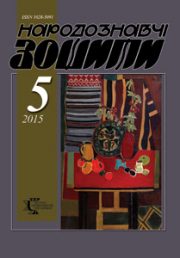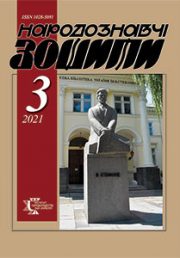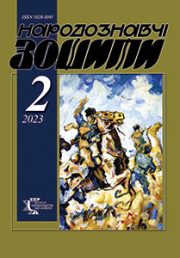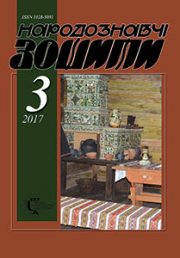The Ethnology Notebooks. 2023. № 2 (170), 299—306
UDK7.03+008]:81’42:355.01(477.8)”2022″
DOI https://doi.org/10.15407/nz2023.02.299
CULTURAL AND ARTISTIC PRACTICES IN THE CONTEXT OF STRATEGIES OF RESISTANCE AND DEFENSE IN 2022
BABII Nadiia
- ORCID ID: https://orcid.org/0000-0002-9572-791X
- PhD in Art Studies, Associate Professor,
- Vasyl Stefanyk Precarpathian National University,
- 57, Shevchenka St., 76000, Ivano-Frankivsk, Ukraine,
- Contacts: e-mail: nadiia.babii@pnu.edu.ua
Abstract. The publication examines the essential features of cultural and artistic practices in Western Ukrainian cities in the realities of war 2022. The role of the region as a shelter, humanitarian and cultural center for preserving identity is revealed. Social and cultural reflection on the modes of existence of war as a phenomenon of physical reality and as a discursive construct that exist simultaneously are reproduced through material and symbolic (textual) parameters are taken into account. Reactive and reflexive artistic practices reflect an understanding of the novelty of «war in the city», which requires the application of urban strategies of resistance. Existential differences in the creation of narratives for different target audiences of both local and global society are determined. It is noted that artistic artivism once again actualized the issue of the social content of art, the meaning of culture, mobilizing artists and institutions to the processes of modeling the actual reality and its retrans mission.
The research methodology is based on objective observation and analysis, which made it possible to single out a number of typical artistic practices that were instantly transformed into mobilizing strategies of resistance. The main source material was my own photographic material, publications on social networks, emotional observations of individual random and regular cultural and artistic practices of the first month of the war, my own reflection.The article is supplemented with works from the educational task «War Diaries», created by the author for students specializing in «graphic design» of the Department of Design and Theory of Art of the Educational and Scientific Institute of Arts of PNU on March 14, 2022.
The aim of the study is to record the mobilization practices of the artistic community in Western Ukrainian cities and ways of communicating with a wide international audience through artistic reactivity.
Conclusions. In conclusion, we note that modern realities demonstrate a bright turn of artists to the social and humanitarian aspect. Cultural and artistic practices, which were recently recognized as marginal, now occupy exclusive positions, turning into new military strategies and information weapons, which can be interpreted as a kind of renewal of the avant-garde. The artistic environment creates iconic markers and is itself a marker of the avant-garde as a state of society. The transformations of artistic practices practically do not concern the formal aspects of art, which mainly demonstrate ready-made templates, texts, paraphrases from the everyday, changing their meaning; fighting and attacking prevail as foresight and insight. Traditionally, grassroots initiatives have grown into self-organized group and mass initiatives. Institutionalization in the cultural field is fixed by rapid archiving.
Keywords: artistic artivism, war 2022, Western Ukraine, reactivity, reflection.
Received 25.02.2023
REFERENCES
- Parakhonskyi, B., & Yavorska, H. (2019). Ontology of war and peace: security, strategy, meaning. Kyiv: NISD [in Ukrainian].
- Eshkilev, V. (2022). About cultural and linguistic presence.Retrieved from: https://matrix-info.com/pro-kulturno-movnu-prysutnist/?fbclid=IwAR1cYBKpLT_FEn7FJX5qcvUju1lRmG2M35ckHKYSifD_vfofEzt6qwla16c (Last accessed:20.07.2022) [in Ukrainian].
- Bodnar, A. (2022). White race, black race… Zbruc. Retrieved from: https://zbruc.eu/node/111567(Last accessed:20.07.2022)[in Ukrainian].
- Mysyuga, B. (2022). A war that was a hundred years in the making. Zbruc. Retrieved from: https://zbruc.eu/node/111128 (Last accessed: 20.07.2022) [in Ukrainian].
- Portnikov, V. (2022). The agony of the shadow. Zbruc. Retrieved from: https://zbruc.eu/node/112526?fbclid=IwAR05yGgzeVixTI6YCF_A1osXc-WMoJtBl2aRL_FpPz_IZTUlnP_bQq8Gw9s (Last accessed:20.07.2022) [in Ukrainian].
- Babii, N. (2022). Cultural and artistic practices in the context of the deployment of military discourse. Western Ukrainian chronicles of the first month of the 2022 war.At the International Scientific and Practical Conference «Philosophical and Psychological Aspects of the Spirituality of Sustainable Human Development», april 20, 2022 (Pp. 19—21) [in Ukrainian].
- (2022). Department of Design and Theory of Art. Retrieved from: https://www.facebook.com/kdtm.pnu/photos/a.429868370699293/1659452464407538/?type=3 [in Ukrainian].
- Filonenko, B. (2022). Curator’s text on after the counterattack. Retrieved from: https://festive-octave-bc3.notion.site/48a67b0f2a71400d806ac1075ac13b2b (Last accessed:23.07.2022) [in Ukrainian].
- #MyStrong: Andruhovych and the National Ivano-Frankivsk Theater told the story of the stolen song. Retrieved from: https://www.youtube.com/watch?v=di-HFwTDLq0&t=5s&ab_channel=%D0%A2%D0%A1%D0%9D (Last accessed:20.07.2022) [in Ukrainian].
- Weber, P. (2022). How «Russian warship, go f-k yourself» became Ukraine’s «Remember the Alamo!» The Week. Retrieved from: https://theweek.com/russo-ukrainian-war/1010613/how-russian-warship-go-f-k-yourself-became-ukraines-remember-the-alamo
- (2022). Сan art change war? JR marches through lviv, ukraine with 100 local volunteers. Retrieved from: https://www.designboom.com/art/jr-lviv-ukraine-valeriia-refugee-mural-nft-100-local-volunteers-03-22-2022/
- Turina, S. (2022). We are the slice. Retrieved from: Stanislav Turina https://www.instagram.com/stanislavturina/
- Klemko, R. (2022). Displaced artists in Lviv create antiwar work to tell the story of Ukraine. Retrieved from: https://www.washingtonpost.com/world/2022/04/17/lviv-ukraine-artists-trauma/ (Last accessed:22.07.2022).
- A few observations of Yuliia Hnat on the official program of the conference_in_Lugano. Retrieved from: https://www.facebook.com/MOCAORGUA/posts/pfbid0tcem2E18XdDp7uKASVnn6gPnWkLyZhkxnUwPa6fwVAgiUEQ3dfp48h3[in Ukrainian].







